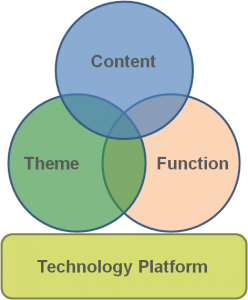
A great website can help your organization in many ways … from finding more customers to making your existing ones even happier.
Building a great website means having a clear concept of what type of experience will deliver the most value to your customers and the most uplift for your business or organization. While you need your website to tell your story, you want that story to be told from a customer-centric perspective. That will allow you to engage your visitors quickly and keep them engaged long enough to ‘sell’ them on your products and services.
4 Parts of a Website
A website can be viewed as having four parts that interconnect and work together to make you website do what it needs to do. Thinking in terms of this framework helps us (and you) think more clearly about how to build a great website for your organization.
 Content is the information you plug into the website that is unique to your business or industry. Content normally consists of words, images, and videos and is, for the most part, what you use to tell your story to your website visitors. On most websites, the content is generated mostly by the website owner, but there are sites where visitors are the primary content creators (e.g., Facebook, YouTube).
Content is the information you plug into the website that is unique to your business or industry. Content normally consists of words, images, and videos and is, for the most part, what you use to tell your story to your website visitors. On most websites, the content is generated mostly by the website owner, but there are sites where visitors are the primary content creators (e.g., Facebook, YouTube).- Theme is the realization of your website design in programming code. The theme controls the way your content is displayed on your website — from the overarching visual concept to the page layouts to the line spacing between paragraphs. Modern themes are built in such a way that they can be easily changed and updated.
- Function is the particular set of capabilities your website employs to support your customer experience. The functionality you need will depend on what your organization does and what it wants to accomplish online. In many cases, the requisite functionality will come as part of the web platform you select or from the library of plug-ins (aka modules) associated with it. In other cases, custom coding may be required to produce the functionality you need.
- Technology platform relates to two things: the web technology platform you select to build your website in and the hosting environment that platform runs on. There are a number of excellent web platforms to choose from (we recommend Drupal and WordPress) and myriad hosting providers. Today’s web platforms are extremely powerful tool kits that allow you to build most any type of website with minimal custom coding.
Website Development Process
Whether you are updating your existing website or building out an entirely new one, Webdot can help you create a successful website that your customers will love.
Where many companies focus initially on the design concept, we focus first on what your website needs to do – both in terms of the content your website needs to present and the functionality you will need to deliver the right user experience. Once you have a clear idea of the ‘what’, then you can productively focus on the aesthetic and design elements that will best help you accomplish your objectives.
Webdot follows a general 3-step process for building a website:
- Phase 1: Planning. This step includes outlining the business requirements for your site and then laying out the capabilities needed to deliver them.
- Phase 2: Development. Development involves building out the main elements of the site and include setting up the technology platform, creating your content, developing the design, and implementing all requisite functionality.
- Phase 3: Deployment. Deployment involves the final steps needed to put your site up live on the web such as browser testing, internal review, and user testing.
For details on what these steps entail, please read more about our website development process.
When you are ready, please give us a shout and let’s us know how we can help.
